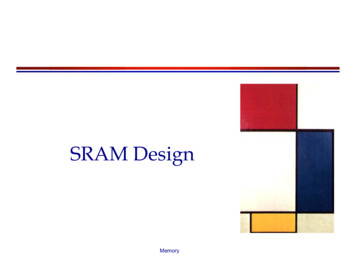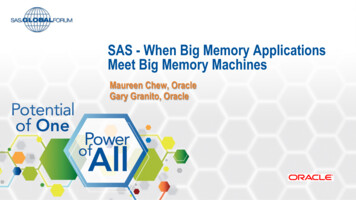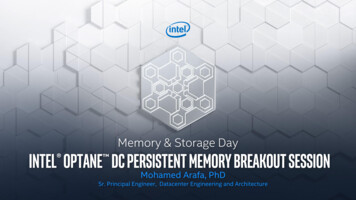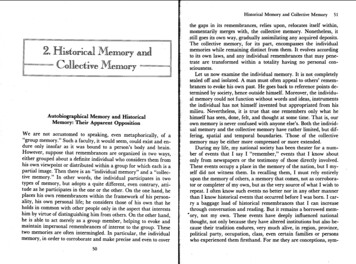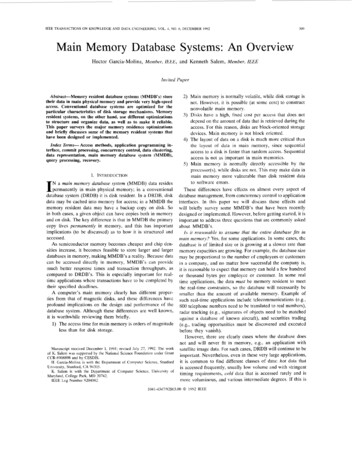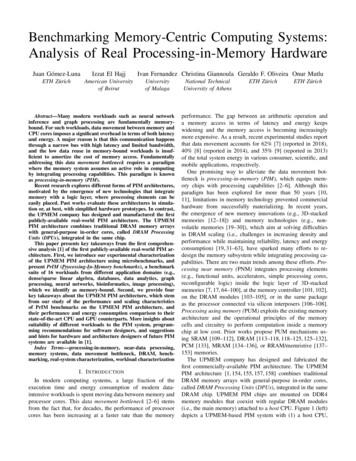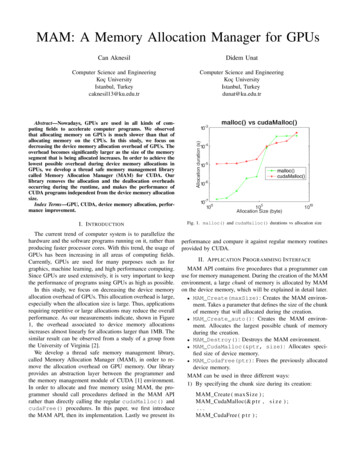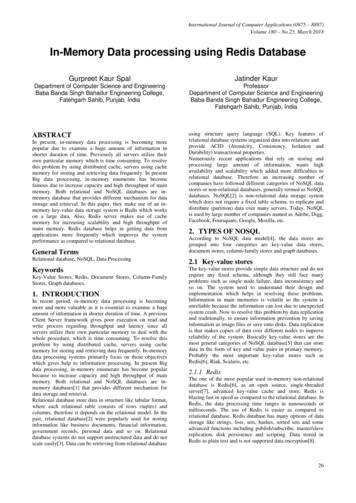
Transcription
International Journal of Computer Applications (0975 – 8887)Volume 180 – No.25, March 2018In-Memory Data processing using Redis DatabaseGurpreet Kaur SpalJatinder KaurDepartment of Computer Science and EngineeringBaba Banda Singh Bahadur Engineering College,Fatehgarh Sahib, Punjab, IndiaProfessorDepartment of Computer Science and EngineeringBaba Banda Singh Bahadur Engineering College,Fatehgarh Sahib, Punjab, IndiaABSTRACTIn present, in-memory data processing is becoming morepopular due to examine a huge amount of information inshorter duration of time. Previously all servers utilize theirown particular memory which is time consuming. To resolvethis problem by using distributed cache, servers using cachememory for storing and retrieving data frequently. In presentBig data processing, in-memory enumerate has becomefamous due to increase capacity and high throughput of mainmemory. Both relational and NoSQL databases are inmemory database that provides different mechanism for datastorage and retrieval. In this paper, they make use of an inmemory key-value data storage system is Redis which workson a large data. Also, Redis server makes use of cachememory for increasing scalability and high throughput ofmain memory. Redis database helps in getting data fromapplications more frequently which improves the systemperformance as compared to relational database.General Termsusing structure query language (SQL). Key features ofrelational database systems organized data into relations andprovide ACID (Atomicity, Consistency, Isolation andDurability) transactional properties.Numerously recent applications that rely on storing andprocessing large amount of information, wants highavailability and scalability which added more difficulties torelational database. Therefore an increasing number ofcompanies have followed different categories of NoSQL datastores or non-relational databases, generally termed as NoSQLdatabases. NoSQL[2] is non-relational data storage systemwhich does not require a fixed table schema, to replicate anddistribute (partition) data over many servers. Today, NoSQLis used by large number of companies named as Adobe, Digg,Facebook, Foursquare, Google, Mozilla, etc.2. TYPES OF NOSQLAccording to NoSQL data model[4], the data stores aregrouped into four categories are key-value data stores,document stores, column-family stores and graph databases.Relational database, NoSQL, Data Processing2.1 Key-value storesKeywordsThe key-value stores provide simple data structure and do notrequire any fixed schema, although they still face manyproblems such as single node failure, data inconsistency andso on. The system need to understand their design andimplementation which helps in resolving these problems.Information in main memories is volatile so the system isunreliable because the information can lost due to unexpectedsystem crash. Now to resolve this problem by data replicationand traditionally, to ensure information prevention by savinginformation as image files or save onto disks. Data replicationis that makes copies of data over different nodes to improvereliability of the system. Basically key-value stores are themost general categories of NoSQL database[5] that can storedata in the form of key and value pairs in primary memory.Probably the most important key-value stores such asRedis[6], Riak, Scalaris, etc.Key-Value Stores, Redis, Document Stores, Column-FamilyStores, Graph databases.1. INTRODUCTIONIn recent period, in-memory data processing is becomingmore and more valuable as it is essential to examine a hugeamount of information in shorter duration of time. A previousClient Server framework gives poor execution on read andwrite process regarding throughput and latency since allservers utilize their own particular memory to deal with thewhole procedure, which is time consuming. To resolve thisproblem by using distributed cache, servers using cachememory for storing and retrieving data frequently. In-memorydata processing systems primarily focus on those objectiveswhich gives help to information processing. In present Bigdata processing, in-memory enumerate has become popularbecause to increase capacity and high throughput of mainmemory. Both relational and NoSQL databases are inmemory databases[1] that provides different mechanism fordata storage and retrieval.Relational database store data in structure like tabular format,where each relational table consists of rows (tuples) andcolumns, therefore it depends on the relational model. In thepast, relational database[2] were popularly used for storinginformation like business documents, financial information,government records, personal data and so on. Relationaldatabase systems do not support unstructured data and do notscale easily[3]. Data can be retrieving from relational database2.1.1 RedisThe one of the most popular used in-memory non-relationaldatabase is Redis[6], as an open source, single-threadedserver[7], advanced key-value cache and store. Redis isblazing fast in speed as compared to the relational database. InRedis, the data processing time ranges in nanoseconds ormilliseconds. The use of Redis is easier as compared torelational database. Redis database has many options of datastorage like strings, lists, sets, hashes, sorted sets and someadvanced functions including publish/subscribe, master/slavereplication, disk persistence and scripting. Data stored inRedis as plain text and is not supported data encryption[8].26
International Journal of Computer Applications (0975 – 8887)Volume 180 – No.25, March 20182.2 Document stores2.4 Graph databasesThe document stores contain collection of documentsincluding JSON (JavaScript Object Notation), XML(Extensible Markup Language) and so on; can help in storingand retrieving documents[4]. No joins are available indocument databases as compared to relational database. Ingeneral, it is used for storing and managing big data- sizecollections of complex documents. As compared to relationaldatabase, ACID transactional properties are not supported bydocument stores. There is some of the most importantdocument stores are SimpleDB, CouchDB, etc.The graph databases[4] are category of the NoSQL database,stores data in the form of a graph. In graph databases, thegraph is made up of two things: nodes act as the entities orobjects and edges act as the relationship between the entitiesor objects. The graph databases are gaining attraction as theyare currently being handled in organizations for managinginformation within applications like social networkingapplications[4], content management, security and accesscontrol, networking and cloud management etc. There aresome of the graph databases are Neo4j, OrientDB, etc.2.3 Column family stores3. DESIGN AND IMPLEMENTATIONThe column family stores are very sparse which primarilywork on columns where each column is treated independently.Column family stores are specifically useful in handling largeamounts of information distributed over different nodes.These systems can easily replicating data to increase thenumber of nodes in the cluster. Most efficiently used columnfamily stores are Cassandra, HBase, HyperTable, etc.In this section, they will give detail about two proposeddesigns are Read data from relational database and Readdata from redis database. They will show their details andhow they are implemented in the following subsections.3.1 Read data from relational databaseIn this subsection, they will give detail about the proposeddesign of “Read data from relational database” and alsodiscuss the implementation steps of the following design inthe flow chart.StartInstall JDKInstall and run eclipseGet sample dataCreate sample data of different sizeApply iterationsStopFig 1: Flow chart of read sample data from relational databaseFig. 1 shows how this method works. Initially, they willinstall JDK (Java Development Kit) contains in addition thedevelopment tools to create java programs. Then install andrun eclipse is an integrated development environment whichmay be used to develop in different programming languages.Then get sample data in CSV (Comma Separated Values)format which has a strict tabular structure. Creating sampledata of different size by adding or deleting values from thesample data for testing the execution time. Finally applyiterations and calculate the execution time.3.2 Read data from redis databaseIn this paper, they mainly consider the method whichimproves the system performance by reading data morefrequently from applications and also saves time.27
International Journal of Computer Applications (0975 – 8887)Volume 180 – No.25, March 2018StartCreate connection with redis serverIf jedisdependencyErrorgeneratedEstablish connection successfullyGenerate key-values of sample dataSet sample data in redis databaseGet sample data from redis databaseApply iterationsCalculate the execution timeStopFig 2: Flow chart of read sample data from redis databaseFig. 2 shows how to read sample data from redis database.Implementation of this method is developed in Java as code inthe backend provide application program interface with theredis-client and redis server. If there is no jedis dependencythen it gives error and stop. For redis, a client library in Javais termed as jedis, is driven by a key store data structure topersist data. By Adding jedis dependency that helps in makingconnection successful with redis database. Create sample datain key-value format and store into it. SET command sets thevalue stored at the given key. The redis database stored data inthe form of key-value pairs but it can also view as JSON andplain text. GET command fetches the value stored at the givenkey. Get the sample data from redis database and then applyiterations where different sizes of sample data are getting(reading) from it. Finally, calculate the execution time and theformula for calculating the execution time is:Execution time End time – Start time4. EXPERIMENTAL RESULTS4.1 Test environmentIn this experiment, the use Redis Desktop Manager 0.8.8.384as a baseline for performance evaluation. The proposedmethods are also implemented on this version of RedisDesktop manager. They use their own benchmarkimplemented in Java to test the performance of Redis databaseand relational database. The software requirements are:operating system (Windows (64-bit)), platform (Windows),and tool (Eclipse) and hardware requirements are MinimumDual core processor operating at 3.6 GHz or above, 160 GBhard disk and RAM (2 GB or above).4.2 Comparative evaluation of relationaldatabase and redis database on a singlemachineThe performance of proposed work that read sample datafrom relational database has been evaluated the performancesparameters: size of sample data and execution time. Fig 328
International Journal of Computer Applications (0975 – 8887)Volume 180 – No.25, March 2018Execution time (ms)shows the execution of relational database in ms(milliseconds) and the sample data in CSV (Comma SeparatedValues) format which has a strict tabular structure. It alsoshows the sample data of different size for testing theexecution time. Fig 4 shows the execution time in ms(milliseconds) of getting key-value data and the sample dataof different size for testing the execution time. Thecomparisons of execution time of Relational database withRedis database as shown in Fig. 5. Redis database supportsgetting multiple values in a single command to speed upcommunication with the client libraries. A very high readspeed is achieved by Redis database as compared toRelational ize of sample data2kb103Relational database11kb26534kb29711mb1150235mb30144Fig 3: Time taken during reading of sample data from relational databaseExecution time (ms)1501005002kb11kb34kb11mbSize of sample dataRedis database2kb2311kb3635mb34kb 11mb 35mb4161139Fig 4: Time taken during reading of sample data from redis database29
International Journal of Computer Applications (0975 – 8887)Volume 180 – No.25, March 2018Execution time (ms)35000300002500020000150001000050000Relational s database23364161139Fig 5: Compare the reading time of relational and redis database5. RELATED WORKSThe qualitative comparison of in-memory data managementsystems[1] are Relational databases, NoSQL databases, Graphdatabases, Cache systems, Big data analysis systems and realtime processing systems on multiple dimensions. Thecomparison of Relational and NoSQL databases on the basisof the security issues[2], where security is necessary today.NoSQL databases are very popular today because of theirability to support for structured and unstructured data andperform heavy write operations with low latency[3]. Thefeature analysis of different categories of NoSQL databasesand selecting databases on the basis of query handling insocial networks[4]. They has been examined that how muchtime taken by applications during inserting and readingoperations. Rick Cattell have discussed a number of SQL andNoSQL data stores[5] on their data models with examples.J.L. Carlson proposed that how to use Redis[6] on the systemand also explain simple interaction with it using example ofkey-value data storage system which is useful in solving realproblems. A comparison between several NoSQL databaseswith comments and notes[9]; to offer high performance on thebasis of their speed.6. CONCLUSIONIn this paper, they make use of an in-memory key-value datastorage system is Redis which works on a large data. Redis isblazing fast in speed on reading process as compared to therelational database. The major problem is a previous ClientServer framework gives poor execution on read and writeprocess regarding throughput and latency since all serversutilize their own particular memory to deal with the wholeprocedure, which is time consuming. To resolve this problemby using distributed cache, redis server using cache memoryfor storing and retrieving data frequently. Also, Redis servermakes use of cache memory for increasing scalability andhigh throughput of main memory. In Redis, the dataprocessing time ranges in nanoseconds or milliseconds asshown in these experimental results.The future work includes other NoSQL databases such asMongoDB, Riak, CouchDB and so on, will create cloudenvironment for reading and writing large amount of data.NoSQL databases will proceed to command and be adjustedto the necessities.7. REFERENCES[1] Zhang, H., Chen, G., Ooi, B.C., Tan, K.L. andZhang, M., 2015. In-memory big data managementand processing: A survey. IEEE Transactions onKnowledge and Data Engineering, 27(7), pp. 19201948.[2] Mohamed, M.A., Altrafi, O.G. and Ismail, M.O.,2014. Relational vs. nosql databases: A survey.International Journal of Computer and InformationTechnology, 3(03), pp. 598-601.[3] Jogi, V.D. and Sinha, A., 2016, March. Performanceevaluation of MySQL, Cassandra and HBase forheavy write operation. In Recent Advances inInformation Technology (RAIT), 2016 3rdInternational Conference on (pp. 586-590). IEEE.[4] Mathew, A.B. and Kumar, S.M., 2015, August.Analysis of data management and query handling insocial networks using NoSQL databases. InAdvances in Computing, Communications andInformatics(ICACCI),2015InternationalConference on (pp. 800-806). IEEE.[5] Cattell, R., 2011. Scalable SQL and NoSQL datastores. Acm Sigmod Record, 39(4), pp. 12-27.[6] Carlson, J.L., 2013. Redis in Action. ManningPublications Co.[7] Lubis, R. and Sagala, A., 2015, October. Multithread performance on a single thread in-memorydatabase. In Information Technology and ElectricalEngineering (ICITEE), 2015 7th InternationalConference on (pp.571-575). IEEE.[8] Sahafizadeh, E. and Nematbakhsh, M.A., 2015. ASurvey on Security Issues in Big Data and NoSQL.Advances in Computer Science: an InternationalJournal, 4(4), pp. 68-72.30
International Journal of Computer Applications (0975 – 8887)Volume 180 – No.25, March 2018[9] Tudorica, B.G. and Bucur, C., 2011, June. Acomparison between several NoSQL databases withcomments and notes. In Roedunet InternationalConference (RoEduNet), 2011 10th (pp. 1-5). IEEE.[10] Zaki, A.K. and Indiramma, M., 2015, March. Anovel redis security extension for NoSQL databaseusing authentication and encryption. In Electrical,Computer and Communication Technologies(ICECCT), 2015 IEEE International Conference on(pp. 1-6). IEEE.[11] Chen, S., Tang, X., Wang, H., Zhao, H. and Guo,M., 2016, August. Towards Scalable and ReliableIn-Memory Storage System: A Case Study withRedis. In Trustcom/BigDataSE/I SPA, 2016 IEEE(pp. 1660-1667). IEEE.[12] Saad, W., Abidi, L., Abbes, H., Cérin, C. and Jemni,M., 2014, October. Wide Area bonjougrid as a datadesktop grid: Modeling and implementation on topof redis. In Computer Architecture and HighPerformance Computing (SBAC-PAD), 2014 IEEE26th International Symposium on (pp. 286-293).IEEE.[13] Wu, X., Long, X. and Wang, L., 2013, December.Optimizing Event Polling for Network-IntensiveApplications: A Case Study on Redis. In Paralleland Distributed Systems (ICPADS), 2013International Conference on (pp. 687-692). IEEE.31IJCATM : www.ijcaonline.org
The one of the most popular used in-memory non-relational database is Redis[6], as an open source, single-threaded server[7], advanced key-value cache and store. Redis is . The qualitative comparison of in-memory data management systems[1] are Relational databases, NoSQL databases, Graph


